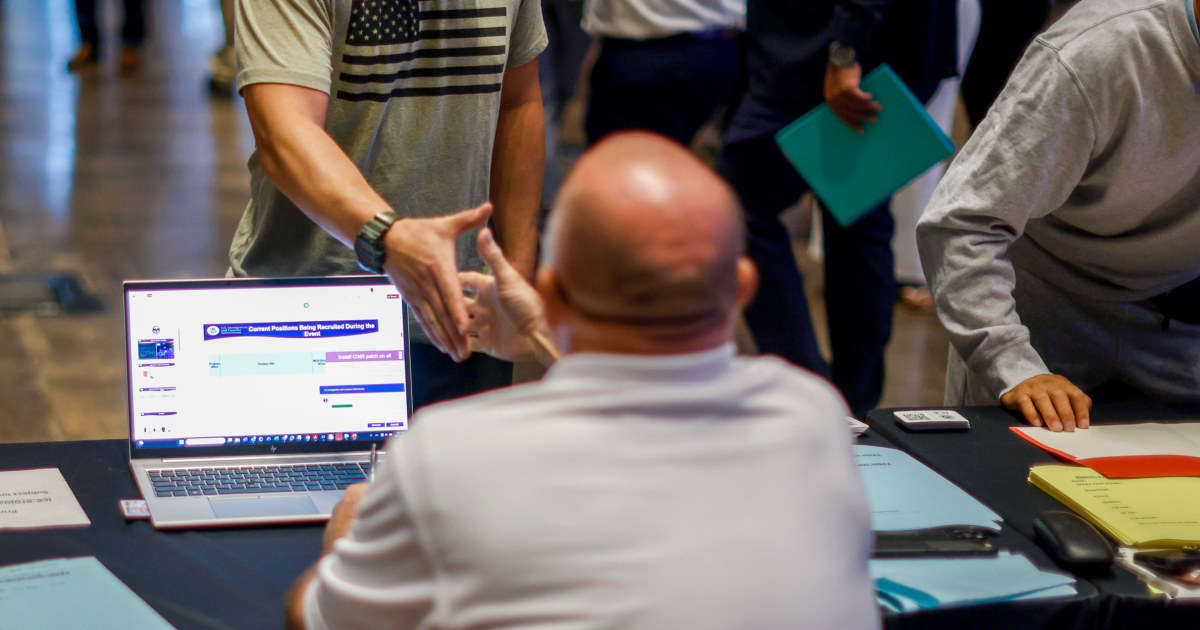WASHINGTON — Immigration and Customs Enforcement has placed new recruits into its training program before they have completed the agency’s vetting process, an unusual sequence of events as the agency rushes to hire federal immigration officers to carry out President Donald Trump’s mass deportation policy, one current and two former Homeland Security Department officials told NBC News.
ICE officials only later discovered that some of these recruits failed drug testing, have disqualifying criminal backgrounds or don’t meet the physical or academic requirements to serve, the sources said.
Staff at ICE’s training academy in Brunswick, Georgia, recently discovered one recruit had previously been charged with strong arm robbery and battery stemming from a domestic violence incident, the current DHS official said. They’ve also found as recently as this month that some recruits going through the six-week training course had not submitted fingerprints for background checks, as ICE’s hiring process requires, the current and former DHS officials said.
Per ICE policy, applicants are required to pass a drug test and undergo a security vetting through ICE’s human resources office prior to showing up for the training course. The former officials said that process was more strictly adhered to before a hiring surge that began this summer. That process was meant to weed out disqualified candidates before they would be sent to training.
Since the surge began, the agency has dismissed more than 200 new recruits while in training for falling short of its hiring requirements, according to recently collected internal ICE data reviewed by NBC News.
The majority of them failed to meet ICE’s physical or academic standards, according to the data. Just under 10 recruits were dismissed for criminal charges, failing to pass drug tests or safety concerns that should have been flagged in a background check prior to arriving at training, the data indicated and the current and former DHS officials confirmed.
The officials said there is growing concern that in the Trump administration’s race to expand the number of ICE agents to 10,000 by the end of the year, the agency could miss red flags in the backgrounds of some new recruits and inadvertently hire them.
“There is absolutely concern that some people are slipping through the cracks,” the current DHS official said. The official said many of the issues that have been flagged during training only surface because the recruits admitted they did not submit to fingerprinting or drug testing prior to arriving.
“What about the ones who don’t admit it?” the official said.
In a statement to NBC News, the Department of Homeland Security said most of its new recruits are former law enforcement officers and former ICE officers who go through a different process.
“The figures you reference are not accurate and reflect a subset of candidates in initial basic academy classes,” said DHS assistant secretary for public affairs Tricia McLaughlin. “The vast majority of new officers brought on during the hiring surge are experienced law enforcement officers who have already successfully completed a law enforcement academy. This population is expected to account for greater than 85% of new hires. Prior-service hires follow streamlined validation but remain subject to medical, fitness, and background requirements.”
The Atlantic reported this week on the struggle some ICE recruits have had with meeting the agency’s physical fitness requirements. The broader scope of issues and specific data have not been previously reported.
ICE has been under pressure from the White House to increase hiring with the funding designated by Congress in the sweeping tax and spending bill that Trump signed into law on July 4. The agency has frequently lagged behind the White House’s arrest goal of 3,000 per day, which they have attributed to a lack of manpower.
As part of the effort, ICE shortened the training at the Federal Law Enforcement Training Center (FLETC) in Georgia from 13 weeks to eight weeks. The training was later shortened to six weeks, the DHS official said.
Recruits also are supposed to attest that they can pass ICE’s physical fitness test, which includes sit-ups, pull-ups, and running one-and-a-half miles in under 14 minutes and 25 seconds.
Darius Reeves, who recently left his position as ICE field office director in Baltimore, said he believes the agency’s Aug. 6 decision to waive age limits so that older people can join has led to more recruits failing the physical test.
“These new recruits are dropping like flies,” Reeves said in an interview after speaking with colleagues seeking to bring new hires into the agency. “And rightly so, it makes sense. We’re going to drop the age requirements, of course this was going to happen.”
Nearly half of new recruits who’ve arrived for training at FLETC over the past three months were later sent home because they could not pass the written exam, according to the data. The academic requirement includes an exam where officers are allowed to consult their textbooks and notes at the end of a legal course on the Immigration and Nationality Act and the Fourth Amendment, which outlines when officers can and cannot conduct searches and seizures.
A slightly smaller group was dismissed because they failed the physical fitness test or had medical challenges, though some of those sent home had made clear on their application that they could not meet ICE’s physical requirements but were sent to training anyway, the current and former DHS officials said.
Fewer than 10 of the new recruits were dismissed because ICE training leaders learned from the recruits during the training program that they had pending criminal charges, failed their drug test or were otherwise considered a safety concern, the officials said.
The three sources said the agency’s human resources office is overwhelmed with more than 150,000 new applicants that have applied since ICE began offering $50,000 signing bonuses in August. The HR office is rushing to clear new recruits, which they believe is leading to mistakes.
“They are trying to push everyone through, and the vetting process is not what it should be,” said one of the former DHS officials with knowledge of the agency’s hiring.
The current DHS official likened the pressure on ICE’s human resources employees to clear recruits to “asking them to pull a rabbit out of a hat.”
First Appeared on
Source link













